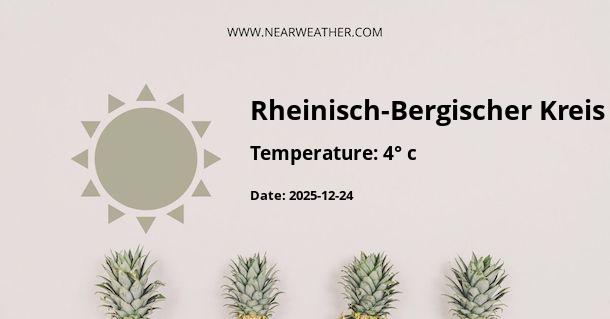Exploring the Climate and Weather of Rheinisch-Bergischer Kreis, Germany
Rheinisch-Bergischer Kreis is a district (Kreis) in the Cologne Bonn Region of North Rhine-Westphalia, Germany. Understanding the climate and weather patterns within this region is crucial for residents, visitors, and businesses alike. In this comprehensive analysis, we will delve into the diverse aspects of the climate of Rheinisch-Bergischer Kreis, offering a detailed insight into what one can expect throughout the year.
Overview of Rheinisch-Bergischer Kreis
Situated to the east of the Rhine river, the Rheinisch-Bergischer Kreis includes towns such as Bergisch Gladbach, Burscheid, and Wermelskirchen, among others. The topography of the district ranges from the low mountains of the Bergisches Land to the Rhine-Ruhr metropolitan area, which significantly influences the local weather conditions.
Climate Classification
The climate in Rheinisch-Bergischer Kreis can be classified as a temperate oceanic climate (Köppen climate classification: Cfb), characterized by mild to warm summers, cool winters, and precipitation distributed throughout the year.
Seasonal Weather Patterns
The weather in Rheinisch-Bergischer Kreis exhibits four distinct seasons, each bringing different weather phenomena and temperature ranges.
Spring
In spring, the region slowly transitions from the cold winter conditions to milder temperatures. The weather can be quite unpredictable, with occasional cold snaps still possible, especially early in the season.
- Temperature Range: Average lows of 1°C (34°F) in March to average highs of 19°C (66°F) in May.
- Precipitation: Moderate rainfall with an increasing trend towards the end of the season.
- Daylight: Rapidly increasing daylight hours, with daylight saving time increasing evening light.
Summer
Summer sees the warmest temperatures of the year with increased sunshine hours but also brings with it the potential for heavy thunderstorms. The proximity to the Rhine river and the low mountainous terrain can lead to localized weather patterns.
- Temperature Range: Average highs of 23°C (73°F) in June to 25°C (77°F) in July and August.
- Precipitation: Occasional thunderstorms, especially in June and July, can lead to heavy precipitation events.
- Daylight: Longest days of the year around the summer solstice, offering up to 16 hours of daylight.
Autumn
Autumn is a transitional period as temperatures cool and days become noticeably shorter. Weather conditions can be quite variable, with an increasing chance of fog, especially in the mornings.
- Temperature Range: Averages from highs of 19°C (66°F) in September to lows of 3°C (37°F) in November.
- Precipitation: Rainfall increases in October and November, contributing to a damp environment.
- Daylight: Daylight hours decrease significantly, with a switch back from daylight saving time shortening the evenings.
Winter
Winters are cool with overcast skies dominating much of the season. Snowfall occurs, but heavy snow is infrequent. Frost and ice can be expected, particularly in January and February, the coldest months of the year.
- Temperature Range: Average highs barely reach 4°C (39°F) in January, and night-time lows can drop to -1°C (30°F).
- Precipitation: Snow is more likely than rain, but overall drier compared to autumn.
- Daylight: Shortest days of the year occur in December, with less than 8 hours of daylight.
Year-Round Weather Statistics for Rheinisch-Bergischer Kreis
The following table summarizes the average climatic conditions in Rheinisch-Bergischer Kreis on a monthly basis:
| Month | Avg. High (°C) | Avg. Low (°C) | Precipitation (mm) | Sunshine Hours |
|---|---|---|---|---|
| January | 4 | -1 | 61 | 40 |
| February | 5 | -1 | 54 | 70 |
| March | 10 | 1 | 68 | 110 |
| April | 15 | 4 | 57 | 158 |
| May | 19 | 8 | 72 | 200 |
| June | 23 | 12 | 92 | 218 |
| July | 25 | 14 | 87 | 229 |
| August | 24 | 14 | 79 | 216 |
| September | 19 | 11 | 87 | 156 |
| October | 15 | 7 | 66 | 118 |
| November | 9 | 3 | 70 | 72 |
| December | 4 | 0 | 74 | 45 |
Source: Meteorological data from the nearest weather station.
Extreme Weather and Climate Events
Rheinisch-Bergischer Kreis, like many regions around the world, is susceptible to extreme weather events. Heavy rains can lead to flooding, particularly in low-lying areas and along the tributaries of the Rhine. In the winter months, snowstorms and ice can disrupt transport and lead to dangerous driving conditions.
Climate Change Considerations
Climate change is an ever-present global concern, and Rheinisch-Bergischer Kreis is no exception. The area faces challenges such as increased frequency of heatwaves in the summer and intense rainfall events that could lead to flooding. These trends necessitate climate adaptation strategies from municipal authorities and local communities.
Conclusion
The climate and weather patterns of Rheinisch-Bergischer Kreis provide a varied and seasonally distinct experience. From its warm summers to its cool winters, precipitation spread throughout the year, and the occasional extreme weather phenomena, residents and visitors must be prepared for a range of conditions. Awareness and understanding of the local climate are integral to the economic and cultural activities in the region, with seasonal events and festivals often tied to the expectations of the weather. As climate change continues to influence weather patterns, ongoing observation and adaptation will be essential for the sustainability and well-being of Rheinisch-Bergischer Kreis.
A - Rheinisch-Bergischer Kreis's Latitude is 51.024441 & Longitude is 7.193890.
A - Weather in Rheinisch-Bergischer Kreis is 3° today.
A - Climate Conditions in Rheinisch-Bergischer Kreis shows moderate rain today.
A - Humidity in Rheinisch-Bergischer Kreis is 99% today.
A - Wind speed in Rheinisch-Bergischer Kreis is 5.54 km/h, flowing at 320° wind direction. today.
